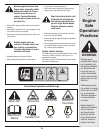
19
IMPORTANT: Used motor oil may cause skin cancer
if repeatedly left in contact with the skin for prolonged
periods. Although this is unlikely unless you handle used
oil on a daily basis, it is still advisable to thoroughly wash
your hands with soap and water as soon as possible
after handling used oil.
NOTE: Please dispose of used motor oil in a manner that
is compatible with the environment. We suggest you take
it in a sealed container to your local service station for
reclamation. Do not throw it in the trash or pour it on the
ground.
Air Cleaner Service
A dirty air cleaner will restrict air flow to the carburetor.
To prevent carburetor malfunction, service the air cleaner
regularly. Service more frequently when operating the
engine in extremely dusty areas.
WARNING: Never use gasoline or low
flash point solvents for cleaning the
air cleaner element. A fire or explosion
could result.
IMPORTANT: Never run the engine without the air
cleaner. Rapid engine wear will result.
1. Remove the wing bolt and the air cleaner cover.
Remove the elements and separate them. See Figure
10-2. Carefully check both elements for holes or tears
and replace if damaged.
2. Foam element: Wash the element in a solution of
household detergent and warm water, then rinse
thoroughly, or wash in nonflammable or high flash
point solvent. Allow the element to dry thoroughly.
Soak the element in clean engine oil and squeeze out
the excess oil. The engine will smoke during initial
start-up if too much oil is left in the foam.
3. Paper element: Tap the element lightly several times
on a hard surface to remove excess dirt, or blow
compressed air through the filter from the inside out.
Never try to brush the dirt off; brushing will force
dirt into the fibers. Replace the paper element if it is
excessively dirty.
Foam Element Part Number: 751-10239
Paper Element Part Number: 751-10240
Spark Plug Service
WARNING: DO NOT check for spark
with spark plug removed. DO NOT
crank engine with spark plug removed.
To ensure proper engine operation, the spark plug must
be properly gapped and free of deposits.
1. Remove the spark plug boot and use a spark plug
wrench to remove the plug. See Figure 10-3.
10
Maintaining
Your
Engine
WARNING
Never use gasoline
or low flash point sol-
vents for cleaning the
air cleaner element.
A fire or explosion
could result.
DO NOT check for
spark with spark plug
removed. DO NOT
crank engine with
spark plug removed.
If the engine has
been running, the
muffler will be very
hot. Be careful not to
touch the muffler.
Figure 10-2
0APER%LEMENT
&OAM%LEMENT
Figure 10-3
3PARK0LUG
3PARK0LUG"OOT
WARNING: If the engine has been
running, the muffler will be very hot. Be
careful not to touch the muffler.
2. Visually inspect the spark plug. Discard the spark plug
if there is apparent wear, or if the insulator is cracked
or chipped. Clean the spark plug with a wire brush if it
is to be reused.
3. Measure the plug gap with a feeler gauge. Correct
as necessary by bending side electrode. See Figure
10-4. The gap should be: 0.70-0.80 mm
4. Check that the spark plug washer is in good condition
and thread the spark plug in by hand to prevent
cross-threading.
5. After the spark plug is seated, tighten with a spark
plug wrench to compress the washer.
NOTE: When installing a new spark plug, tighten 1/2 turn
after the spark plug seats to compress the washer. When
reinstalling a used spark plug, tighten 1/8-1/4 turn after
the spark plug seats to compress the washer.


















